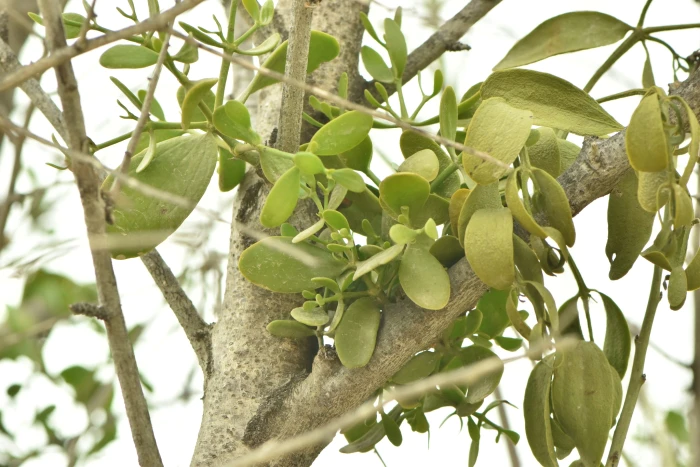Red-Berry Mistletoe
(Viscum cruciatum)
Red-Berry Mistletoe (Viscum cruciatum)
/
/

Lies Van Rompaey
CC BY 4.0
Image By:
Lies Van Rompaey
Recorded By:
Copyright:
CC BY 4.0
Copyright Notice:
Photo by: Lies Van Rompaey | License Type: CC BY 4.0 | License URL: http://creativecommons.org/licenses/by/4.0/ | Rights Holder: Lies Van Rompaey | Publisher: iNaturalist | Date Created: 2022-02-26T15:02:53-08:00 |

























Estimated Native Range
Climate Requirements for Attleboro, Massachusetts
| This Plant | Your Site | Plant Suitability for Your Location | ||
|---|---|---|---|---|
| • Precipitation | 6" - 78" | 47" | Aquatic | Aquatic |
| • High Temp. | 73°F - 98°F | 83°F | Your summer temperatures are normal for this plant. | Excellent |
| • Low Temp. | 10°F - 68°F | 17°F | Your winter temperatures are normal for this plant | Excellent |
This plant may not grow well at your location - your precipitation is too high.
Summary
Viscum cruciatum, commonly known as red-berry mistletoe, is a hemiparasitic evergreen shrub native to various habitats including Mediterranean woodlands, scrub areas, and sometimes in orchards or on different host trees in Lebanon, Morocco, Israel, Palestine, Portugal, Spain, and Syria. It typically grows to a modest size, with small, oval to lance-shaped leaves and inconspicuous yellow-green, four-petaled flowers. The plant is most notable for its bright red berries, which appear in winter and contain one seed each. These berries are a key feature in the plant’s life cycle, as they are attractive to birds that eat them and subsequently disperse the seeds.
Red-berry mistletoe is often used as a Christmas decoration due to its festive-looking berries. In cultivation, it requires a host plant to grow on, as it derives some of its nutrients from its host through haustoria that penetrate the host’s tissue. It prefers sunny to partially shaded conditions and can tolerate a range of soil types, provided they are well-drained. While it is not commonly grown in gardens due to its parasitic nature, it can be of interest for creating wildlife-friendly gardens or for use in traditional holiday decor. Care should be taken as all parts of the plant, except for the berries, are toxic if ingested by humans.CC BY-SA 4.0
Red-berry mistletoe is often used as a Christmas decoration due to its festive-looking berries. In cultivation, it requires a host plant to grow on, as it derives some of its nutrients from its host through haustoria that penetrate the host’s tissue. It prefers sunny to partially shaded conditions and can tolerate a range of soil types, provided they are well-drained. While it is not commonly grown in gardens due to its parasitic nature, it can be of interest for creating wildlife-friendly gardens or for use in traditional holiday decor. Care should be taken as all parts of the plant, except for the berries, are toxic if ingested by humans.CC BY-SA 4.0
Plant Description
- Plant Type: Shrub
- Height: 1-2 feet
- Width: 1-2 feet
- Growth Rate: Slow
- Flower Color: Yellow, Green
- Flowering Season: Spring
- Leaf Retention: Evergreen
Growth Requirements
- Sun: Full Sun, Part Shade
- Water: Medium
- Drainage: Medium
Common Uses
Bird Garden, Low Maintenance
Natural Habitat
Mediterranean woodlands and scrub areas, and sometimes in orchards on different host trees
Other Names
Common Names: Cross-leaved Mistletoe, Southern Mistletoe
Scientific Names: Viscum cruciatum, Viscum album, Viscum cruciatum, Viscum orientale
GBIF Accepted Name: Viscum cruciatum